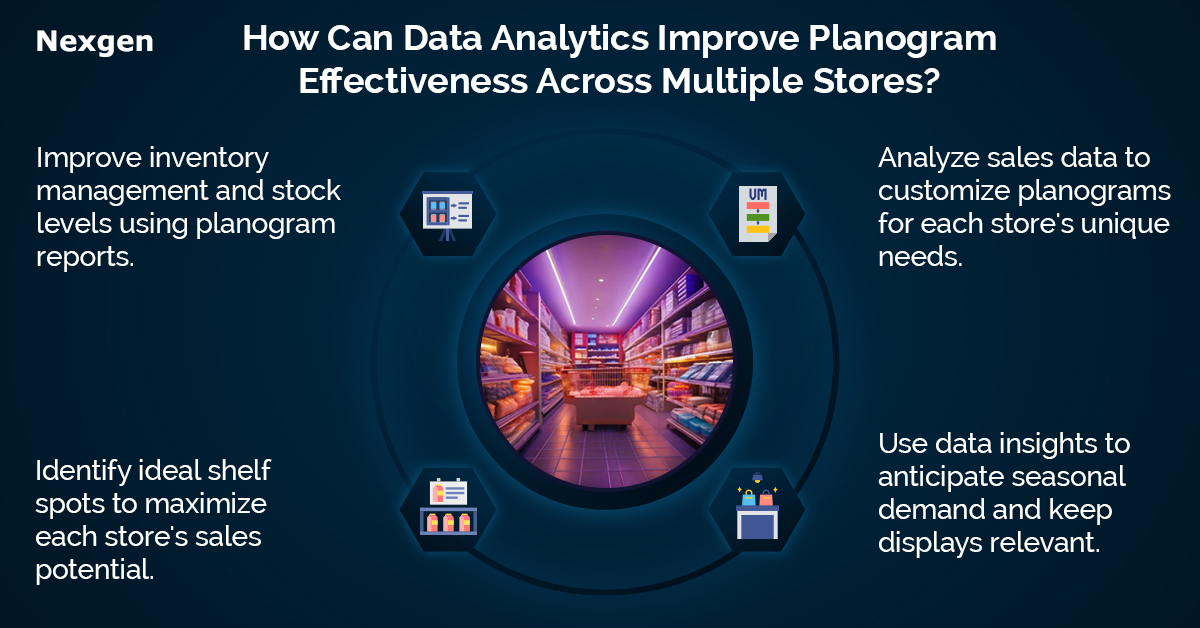In retail, maintaining a competitive edge requires more than just great products. Optimizing retail space with effective planograms is crucial for enhancing customer experience, maximizing sales, and ensuring operational efficiency across multiple store locations. Data analytics, when integrated into planogram management, provides retailers with powerful insights to enhance their store layouts and adapt to market trends. This blog will explore how data analytics can improve planogram services effectiveness across multiple stores.

1. Data-driven insights for optimal product placement.
Data analytics offers valuable insights into customer preferences, buying patterns, and high-demand products. By analyzing inventory levels and sales performance, retailers can tailor their planograms to highlight best-selling products. Data on popular product categories can be utilized to adjust shelving placements, ensuring that high-demand items are positioned in prime locations, increasing visibility and sales. For instance, if your sales data show that a particular product line is performing well in specific regions, planograms across those stores can be adjusted to feature that product more prominently. Conversely, underperforming products can be moved to less visible areas, creating space for high-turnover items.
2. Localized adaptations across multiple stores.
One of the biggest challenges for retailers managing multiple locations is understanding regional and store-specific preferences. Data analytics allows retailers to localize their planograms based on customer demographics, shopping behavior, and cultural preferences. For example, a product that performs well in urban areas may not be as popular in rural regions. By leveraging data, retailers can create localized planograms that cater to each store’s unique audience, ensuring a personalized shopping experience and maximizing sales potential.
3. Improving Inventory management and stock levels.
Efficient inventory management is vital for retailers with multiple stores. Planogram reports can track inventory levels, sales rates, and replenishment cycles, enabling retailers to adjust planograms in response to stock availability. With the help of real-time data, retailers can ensure that their planograms reflect current inventory, avoiding stockouts or overstock situations. For instance, if a particular product is selling out quickly, retailers can make prompt adjustments to the planogram to prioritize that item, ensuring it is restocked and readily available on the shelves using planogram reports.
4. Predicting trends and seasonality.
Seasonal trends have a major impact on consumer behavior. By analyzing sales reports, retailers can anticipate shifts in demand in the emerging market trends. By forecasting these changes, retailers can optimize their planograms for seasonal products, maximizing sales opportunities during peak times like holidays, back-to-school, or other events. For example, during Halloween, retailers can identify the most popular candy or costume categories by using the past sales data. Retailers can then adjust their planograms to showcase these items in high-traffic areas, boosting visibility and sales during the seasonal rush.
5. Measuring planogram performance.
Sales data provides comprehensive reporting on the performance of planograms across multiple stores. By evaluating metrics such as sales per square foot, customer dwell time, and product turnover rates, retailers can assess the effectiveness of their store layouts. These insights help retailers identify underperforming planograms and make data-driven decisions to optimize future layouts. Furthermore, tracking planogram performance across multiple locations helps ensure that the layout strategies align with overall business goals and maximize profitability.
Overview of Nexgen Planogram Services
Nexgen offers store-specific planograms for clients that optimize sales and achieve category objectives. We create customized planograms for your business to ensure that these are better aligned with your goals and merchandising strategies. Our expertise in planogram automation helps us build planograms faster, better and consistently. Whether it is creating a planogram from scratch, or a typical reset, we have the knowledge, tools, and experience to get the job done for you.
Get Your Free Trial Now!